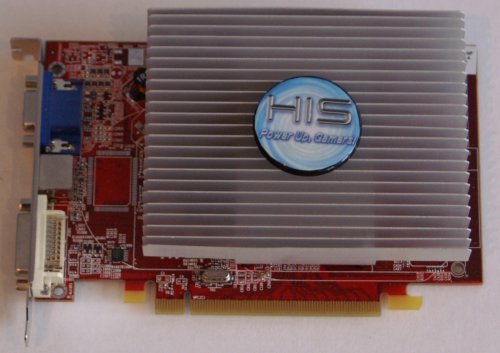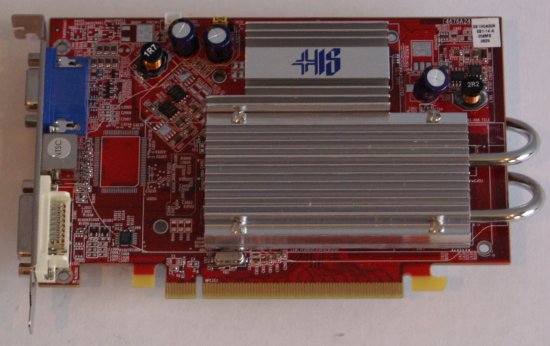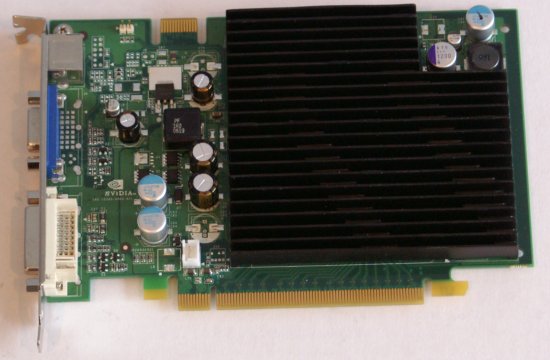HIS

HIS is a company that's well known for its IceQ line of graphics parts, but they also offer silent solutions, and for this review we have two of these. Both use ATI chipsets: the X1600 Pro and X1300 Pro.

The HIS X1600 Pro has a somewhat bulky heat sink design, which has rows of long metal ridges along the whole top of the card. HIS seems to have taken the route of dispelling heat through as much surface area on the heat sink as possible, to good effect. The metal ridges are also much thicker than those on other heat sinks, and the card isn't as delicate as some of the other offerings.

The HIS X1300 Pro has a much more compact heat sink design which extends to the back of the card and is connected via two heatpipes, similar to the ASUS EAX1600 XT. This HIS card has a larger silver heat sink than the ASUS on the front of the card, however, along with a slightly larger sink on the back of about the same thickness.
EVGA

For this review, we have one silent EVGA part, the EVGA e-GeForce 7600 GS. This card is factory clocked at reference speeds (400MHz/800MHz), and sports a modest heat sink design, typical of EVGA. The face of the card has a black heat sink which has rows of thick ridges across the length of it.


HIS is a company that's well known for its IceQ line of graphics parts, but they also offer silent solutions, and for this review we have two of these. Both use ATI chipsets: the X1600 Pro and X1300 Pro.

The HIS X1600 Pro has a somewhat bulky heat sink design, which has rows of long metal ridges along the whole top of the card. HIS seems to have taken the route of dispelling heat through as much surface area on the heat sink as possible, to good effect. The metal ridges are also much thicker than those on other heat sinks, and the card isn't as delicate as some of the other offerings.

The HIS X1300 Pro has a much more compact heat sink design which extends to the back of the card and is connected via two heatpipes, similar to the ASUS EAX1600 XT. This HIS card has a larger silver heat sink than the ASUS on the front of the card, however, along with a slightly larger sink on the back of about the same thickness.
EVGA

For this review, we have one silent EVGA part, the EVGA e-GeForce 7600 GS. This card is factory clocked at reference speeds (400MHz/800MHz), and sports a modest heat sink design, typical of EVGA. The face of the card has a black heat sink which has rows of thick ridges across the length of it.











49 Comments
View All Comments
Leo V - Thursday, August 31, 2006 - link
...I can buy a high-end 7800GT substantially cheaper, buy a quiet Zalman 80mm low-rpm GPU cooler and run it undervolted at 7V. (In fact, I have done exactly that.) It will be cheaper, run WAY cooler, and be quieter, because I can get rid of a case fan that I would need with a "silent" card anyway.The idea of running a 50-100watt GPU with a silent cooler is dubious -- you still need a fan somewhere in your system, and the best place is closest to the hottest parts. Those parts are naturally the CPU and GPU.
Instead of "silent" (but not really) high-end cards, give us cards with heatpipes + large, slow quiet fans that can be undervolted.
Most importantly, ATI and NVIDIA please stop making 100watt monsters and follow Intel's and AMD's lead in improving power efficiency.
yyrkoon - Thursday, August 31, 2006 - link
Sorry, I cant say I would agree that a fan would be quieter than a passive solution, I dont care if you could run it at 1V, and did :)Leo V - Thursday, August 31, 2006 - link
e.g. substantially cheaper than the holy grail "silent" version of the 7800GT.
And Kudos to the companies for the inventive products and to Anandtech for covering them.
hkBst - Thursday, August 31, 2006 - link
I've been waiting for a review of the passively cooled 7900GT from MSI for a while and I was expecting it to be in here. How can it not be?Look here: http://www.msi.com.tw/program/products/vga/vga/pro...">http://www.msi.com.tw/program/products/vga/vga/pro...
DerekWilson - Thursday, August 31, 2006 - link
We sent multiple requests for cards out to 16 different graphics card manufacturers. I'd say we did pretty well with more than half of those responding.We also requested that each manufacturer send us all their passively cooled cards. If something was left out it was either because the manufacturer decided not to send it, or we weren't able to get ahold of it before our submission deadline. We tested a lot of cards and have been working on this for quite some time, so silent cards that have come out recently or were not widely available until recently will not have been included.
JarredWalton - Thursday, August 31, 2006 - link
Also, the MSI 7900GT Silent card is only available in Europe, and we did mention this in the review.haris - Thursday, August 31, 2006 - link
Any chance you could retest the cards using a mid range system. It seems kind of silly to test an FX-55 with a $50-100 video card.nullpointerus - Thursday, August 31, 2006 - link
Yet Another Silly Performance Retest Request (YAMPRR)Testing an FX-55 with a $50-100 video card is not silly; testing graphics cards' performance relative to each other requires removing all other factors including the CPU and RAM. Not everyone has a "mid-range" system, and those who do not have a "mid-range" system do not want the results skewed just to make your life easier. If you want specific performance advice for your particular system and games, why do you not join and post in the forums?
ss284 - Thursday, August 31, 2006 - link
Well considering the majority of people who are looking for midrange graphics cards have a midrange system, his request is a perfectly good one. Unless Anandtech enjoys targeting the minority of its readers it should be doing more applicable performance testing. Then again, the FX-55 isnt exactly a cutting edge processor anymore. Just scale everything back 10% and you will have a rough estimate of what performance would be like on a mid range system.nullpointerus - Thursday, August 31, 2006 - link
Yet Another Defense of a YAMPRR (YADY). *yawn*Well considering the majority of people who are looking for midrange graphics cards have a midrange system, his request is a perfectly good one.
No, it's a silly one. The point of the article is to compare graphics cards, not to make life easier for a certain group of people. People who follow this esoteric stuff religiously tend to distill the information into a more practical form. And as I said, the information he wanted is readily available in the forums. A couple of mouse clicks and a bit of typing is better than ignorantly saying the video card article is silly for not providing framerates similar to some mythical ideal of a mid-range system.
Unless Anandtech enjoys targeting the minority of its readers it should be doing more applicable performance testing.
How about you go where the information is normally provided instead of trying to turn all the front page articles into your personal system upgrade newsfeeds?
Could we just skip ahead to where everyone chimes in with their own ideas of what a mid-range system is. Does it use AMD or Intel? Single or multi-core? How much RAM? Which timings? Which system boards? Which components are overclocked?
I'll make a deal with you: get together a mid-range system that everyone will agree on, and then I will agree with you that we should conflate graphics cards testing with mid-range system testing. You see, ridding the comments section of silly YAMPRR and YADY posts will not benefit anyone if we still have to deal with all the senseless bickering about little details such as chipset revisions, features, and all the other inane griping I have seen posted when Anandtech picks out a CPU, overclocking, or RAM configuration as representative of X-range systems.